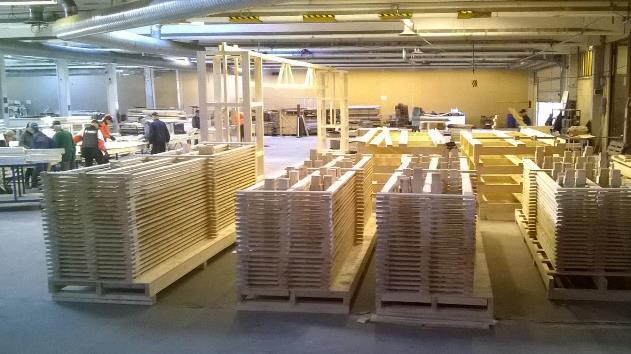The info tent, shop, restaurant and saunas. These are examples of Jukola constructions that need a lot of wood and an innumerable amount of working hours by volunteers. At the moment, three semi-trailer loads of wood dwell in a warehouse at Jukantie road in Paimio, out of which more than a half has already been transformed into final Louna-Jukola structures.
– The amount will be approximately six semi-trailer loads altogether. So far we’ve made for example one kilometer of transferable fence and shower screens, tells Kassu Grönlund, in charge of structures in Jukola.
A part of the wood is “legacy” from previous Jukola Relays. However, several elements also need to be built from scratch.
– Compared to most previous Jukola Relays, Louna-Jukola is different in that all structures will be on asphalt instead of field or other softer surface. We’re not able to ram poles into the ground, which is something we need to take into account. For example, all fences are built with supporting legs, states Grönlund.
Forest unites
The new wood is delivered by Westas Group, a Koski-based lumber industry company.
– We wanted to cooperate precisely with a local, forest related major event, since I strongly see forest as a factor uniting us, says Pekka Kopra, the CEO of Westas Group.
– We delivered the material needed for control equipment already in the autumn, and all the rest of the wood is also ready for the volunteers.
Cooperating with Jukola for the first time, Westas hosts the fifth leg in Jukola Relay. The company will get a feeling of their “own” leg on grass-root level.
– Our goal is to have an own team in the Jukola relay. We have about 135 employees in total, so I’m pretty sure we’re able to assemble one team, evaluates Kopra.
3D models ease the work
The biggest single structure in Louna-Jukola will be a temporary bridge, to be built by officer cadets from the Defence Forces.
– The bridge will be over 42 meters in length and four meters in height. The competitors will go over and the spectators under it, Grönlund clarifies.
The work of the volunteering builders is eased by 3D models made of all elements. Still, they barely cut down working hours.
– I counted that already 700 hours of work have been done. We’re about 25 volunteers working twice a week, the retired usually in the “morning shift” and those with day work in the evening, says Grönlund.
– We’re very well on schedule and there’s no chance for panic, as we have also prepared ourselves for last minute wishes.

Some of the woodworks ready for Jukola. In the foreground e.g. fence elements, farther back the gate guiding competitors arriving to the changeover or finish.





























